Centauri Dreams
Imagining and Planning Interstellar Exploration
Ryugu: An Asteroid’s Interactions with the Sun
The near-Earth asteroid Ryugu is only about a kilometer wide, but it’s telling us a good deal about its own history and that of the Solar System itself thanks to the two touchdowns of Hayabusa2, in February and July of 2019. The geological changes so clear on Earth, the bombardments from objects creating craters here and elsewhere, all mark the evolution of large bodies, but the asteroids take us back to the system’s earliest days with little change. They’re bundles out of the deep freeze of time.
Now we wait for the sample return, currently on its way back to Earth, with arrival in December of this year. Aboard will be surface materials collected during both touchdowns, which will complement the data on the chemical and physical composition of the asteroid already gathered. A team led by Tomokatsu Morota (University of Tokyo) has been using Hayabusa2’s onboard ONC-W1 and ONC-T imaging instruments to analyze the dusty matter kicked up by the spacecraft’s engines during the two touchdowns.
Fine grains of dark-red colored minerals turned up in this analysis. The team believes these were produced by solar heating, indicating close passage by the Sun at some point in Ryugu’s past. This view is reinforced by the distribution of the dark red-matter. Spectral examination shows the material can be found at specific latitudes on the asteroid, corresponding to areas that would have received the most solar radiation in the asteroid’s past. Adds Morota:
“From previous studies we know Ryugu is carbon-rich and contains hydrated minerals and organic molecules. We wanted to know how solar heating chemically changed these molecules. Our theories about solar heating could change what we know of orbital dynamics of asteroids in the solar system. This in turn alters our knowledge of broader solar system history, including factors that may have affected the early Earth.”
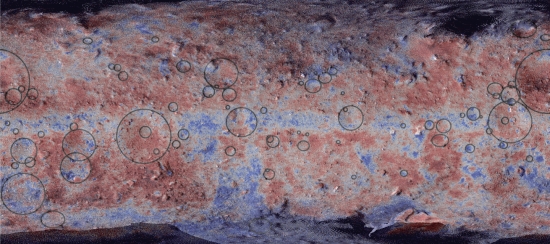
Image: False color map of the surface of Ryugu with craters marked by circles. Credit: © 2020 Morota et al.
The distribution of surface materials suggests a history of disruption by impacts and what the paper describes as thermal fatigue and mass wasting. Let me quote from this section:
The thickness of the mixed layer of redder and bluer materials is estimated to be a few meters, derived from the minimum crater size (~10 m in diameter) that penetrates to the underlying blue materials. The presence of ejecta rays with a length of a few tens of meters that consist primarily of redder materials implies that the redder material layer originally had a minimum thickness of a few tens of centimeters. Solar heating is more likely than space weathering to be the source of the reddening of Ryugu’s surface, because space weathering typically affects only a thin layer of ~100 nm, whereas the diurnal and annual thermal skin depths (the depth at which temperature variations decay to 1/e of their value at the surface) are ≲10 cm and ~1.5 m, respectively.
It’s encouraging to hear from Morota’s group that their spectral studies and examination of Ryugu’s albedo indicate that both the dark-red material once heated by the Sun as well as blue unheated materials would have been collected in Hayabusa2’s two forays to the surface. Also on the agenda in coming months is a close look at the distribution of Ryugu’s craters and boulders. The surface craters hold information about the characteristics of the asteroid’s rocks and the history of small impacts. They also greatly complicated the search for a safe landing site.
What produced the differences between the two types of materials remains unclear:
Two distinct types of material are present on the surface with different colors: bluer material distributed at the equatorial ridge and in the polar regions and redder material in the mid-latitude regions. However, the cause of these spectral variations is not understood.
The paper is Morota et al., “Sample collection from asteroid (162173) Ryugu by Hayabusa2: Implications for surface evolution,” Science Vol. 368, Issue 6491 (8 May 2020), pp. 654-659 (abstract).

The Closest Black Hole to Earth
Black holes are such exotic objects that they somehow suggest great distance. We’re learning about the black holes at the center of many galaxies even as we’re just beginning to catalog the location of smaller ones elsewhere. But we’re also learning through gravitational wave studies about their interactions and have begun to find black holes closer to home. Thus the just announced discovery of a black hole 1,000 light years from Earth. A long way, to be sure, but the closest ever found to our planet.
Evidence for the object comes from the MPG/ESO 2.2-metre telescope at ESO’s La Silla Observatory in Chile, deduced by a team of astronomers led by Thomas Rivinius from observations of two companion stars. This is, in other words, a triple system, and one that can be seen with the naked eye at that. The system is located in Telescopium, its stars viewable without binoculars or telescope on a clear southern hemisphere night. In fact, here’s where to look.
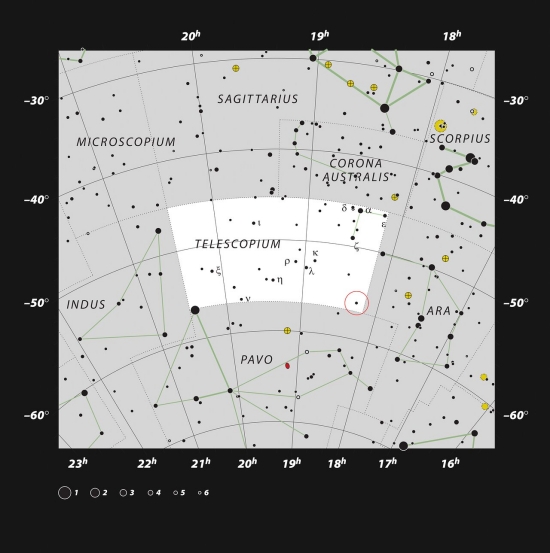
Image: This chart shows the location of the HR 6819 triple system, which includes the closest black hole to Earth, in the constellation of Telescopium. This map shows most of the stars visible to the unaided eye under good conditions and the system itself is marked with a red circle. While the black hole is invisible, the two stars in HR 6819 can be viewed from the southern hemisphere on a dark, clear night without binoculars or a telescope. Credit: ESO, IAU and Sky & Telescope.
The system is HR 6819, which was under study by the Rivinius team as part of an effort targeting double-star systems. It took the FEROS spectrograph on the La Silla instrument to show that one of the two visible stars orbits an unseen object every 40 days. The other star is at a large distance from the inner star/black hole pairing.
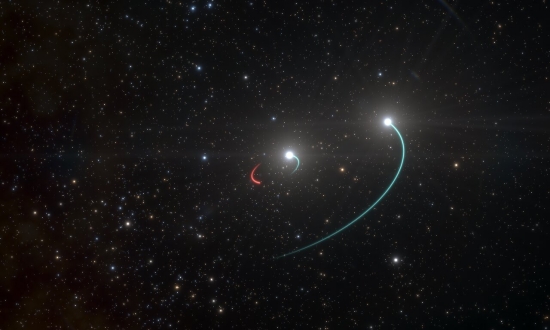
Image: This artist’s impression shows the orbits of the objects in the HR 6819 triple system. This system is made up of an inner binary with one star (orbit in blue) and a newly discovered black hole (orbit in red), as well as a third star in a wider orbit (also in blue). The team originally believed there were only two objects, the two stars, in the system. However, as they analysed their observations, they were stunned when they revealed a third, previously undiscovered body in HR 6819: a black hole, the closest ever found to Earth. The black hole is invisible, but it makes its presence known by its gravitational pull, which forces the luminous inner star into an orbit. The objects in this inner pair have roughly the same mass and circular orbits. The observations, with the FEROS spectrograph on the 2.2-metre telescope at ESO’s La Silla, showed that the inner visible star orbits the black hole every 40 days, while the second star is at a large distance from this inner pair. Credit: ESO/L. Calçada.
We are dealing with a stellar-mass black hole that shows no visible interactions with its environment, and thus had to be deduced from the orbit of the nearby star. As lead author Rivinius notes: “An invisible object with a mass at least 4 times that of the Sun can only be a black hole.” A reasonable conclusion, and a black hole that stands in contrast to the black holes previously discovered in the galaxy, nearly all of which are detectable through strong X-ray emissions as they affect nearby matter.
If we’ve found a black hole this comparatively close to the Solar System, what does this say about their numbers elsewhere? Rivinius speaks in terms of hundreds of millions of black holes, considering how many stars have ended their existence through gravitational collapse into such objects over the lifetime of the galaxy. Marianne Heida (ESO), a co-author of the paper, points to signs of another such system:
“We realised that another system, called LB-1, may also be such a triple, though we’d need more observations to say for sure. LB-1 is a bit further away from Earth but still pretty close in astronomical terms, so that means that probably many more of these systems exist. By finding and studying them we can learn a lot about the formation and evolution of those rare stars that begin their lives with more than about 8 times the mass of the Sun and end them in a supernova explosion that leaves behind a black hole.”
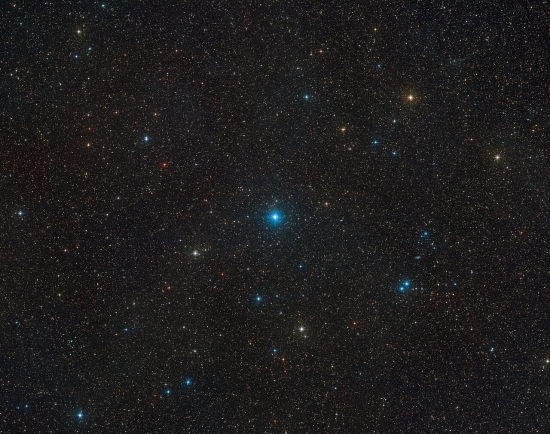
Image: This wide-field view shows the region of the sky, in the constellation of Telescopium, where HR 6819 can be found, a triple system consisting of two stars and the closest black hole to Earth ever found. This view was created from images forming part of the Digitized Sky Survey 2. Credit: ESO/Digitized Sky Survey 2. Acknowledgement: Davide De Martin.
We may also gain insights into the cosmic mergers that gravitational wave astronomy has shown us by studying systems like HR 6819. In such cases, we may be dealing with systems where the inner pairing is made up of two black holes, or a black hole and a neutron star. In that scenario, the outer star in the triple system could interact gravitationally so as to cause a merger that releases gravitational waves.

Before ending today’s article, I want to mention that the Rivinius paper is dedicated to the memory of the Czech astronomer Stanislav (Stan) Štefl, who died recently at age 58 in a car accident in Santiago, Chile. A tribute can be found here. Dr. Štefl worked at ESO Headquarters as a research associate and, from 2004 until 2012, was a Very Large Telescope Interferometer (VLTI) support astronomer at Paranal Observatory. For the past year and a half, he had been on assignment to the Atacama Large Millimeter/ submillimeter Array (ALMA), working in Santiago and at Chajnantor.
Although we discuss objects and distances at scales that defy the imagination, our community is a relatively small one. Such losses are wounds for us all.
The paper is Rivinius et al., “A naked-eye triple system with a non-accreting black hole in the inner binary,” Astronomy & Astrophysics Vol. 637, L3 (May, 2020). Abstract.

Polarimetry Probes Brown Dwarf Clouds
It will surprise few Centauri Dreams readers that at least some brown dwarfs have bands of clouds, just as we see similar bands on our Solar System’s largest planet. In fact, three brown dwarfs have recently shown signs of cloud banding, and today’s subject, Luhman 16, has previously been analyzed in terms of large cloud patches. I think new work based on data from the European Southern Observatory’s Very Large Telescope (VLT) in Chile may be less significant for what it says about brown dwarfs than what it says about how we study them.
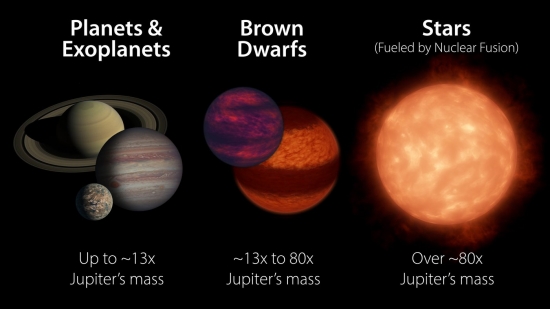
Image: Illustration comparing the masses of planets, brown dwarfs, and stars. Credit: NASA/JPL-Caltech/R. Hurt (IPAC).
For the work in question, reported in a paper from Maxwell Millar-Blanchaer (Caltech) and colleagues, is the first time polarimetry has been put to work to infer bands in brown dwarf clouds. Polarization tells us the direction that a light wave oscillates. Millar-Blanchaer likens polarimetric instruments to polarized sunglasses — here, one direction of polarization is blocked to reduce glare — but adds that astronomers are less concerned with reducing glare than measuring it. Light reflecting off cloud droplets can favor a measurable angle of polarization.
We’re beginning to see methods to analyze polarized light cropping up more and more in astronomy, with implications for exoplanets. Thus Dimitri Mawet (Caltech), a senior research scientist at the Jet Propulsion Laboratory:
“Polarimetry is receiving renewed attention in astronomy. Polarimetry is a very difficult art, but new techniques and data analysis methods make it more precise and sensitive than ever before, enabling groundbreaking studies on everything from distant supermassive black holes, newborn and dying stars, brown dwarfs, and exoplanets, all the way down to objects in our own solar system.”
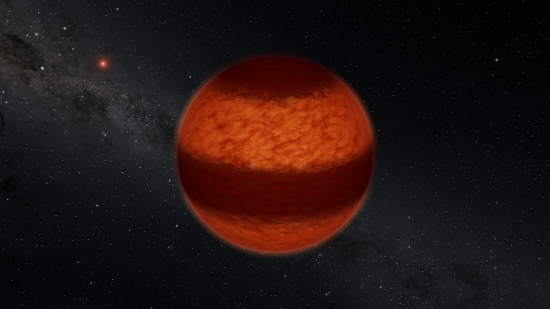
Image: Astronomers have found evidence for a striped pattern of clouds on the brown dwarf called Luhman 16A, as illustrated here in this artist’s concept. The bands of clouds were inferred using a technique called polarimetry, in which polarized light is measured from an astrophysical object much like polarized sunglasses are used to block out glare. This is the first time that polarimetry has been used to measure cloud patterns on a brown dwarf. The red object in the background is Luhman 16B, the partner brown dwarf to Luhman 16A. Together, this pair is the closest brown dwarf system to Earth at 6.5 light-years away. Credit: Caltech/R. Hurt (IPAC).
Luhman 16 draws attention for being the closest known brown dwarf binary, approximately 6.5 light years away. Both brown dwarfs weigh in at roughly 30 times Jupiter’s mass, examples of ‘failed stars’ that formed from collapsing clouds of gas but lacked the mass to ignite hydrogen fusion. Millar-Blanchaer and team used the VLT’s NaCo instrument (Nasmyth Adaptive Optics System, coupled with the Near-Infrared Imager and Spectrograph called CONICA) to study the polarized light from both of the Luhman brown dwarfs. Luhman 16A’s polarization can only be explained by bands of clouds, while the data on bands are inconclusive for Luhman 16B. The latter’s variability in brightness seems to be the result of irregular, patchy clouds instead.
Consider what we’re doing here. It took NASA’s Wide-field Infrared Survey Explorer (WISE) to find Luhman 16 in 2013, and Millar-Blanchaer’s team now detects clouds through polarization that cannot be directly resolved. The scientists used atmospheric modeling run against measurements of the polarized light to infer the presence of the cloud bands on Luhman 16A.
“To determine what the light encountered on its way we compared observations against models with different properties: brown dwarf atmospheres with solid cloud decks, striped cloud bands, and even brown dwarfs that are oblate due to their fast rotation. We found that only models of atmospheres with cloud bands could match our observations of Luhman 16A,” says Theodora Karalidi (University of Central Florida), a member of the discovery team.
The beauty of using polarimetry this way is that it is sensitive to cloud properties, a trait that should serve us well not only with brown dwarf atmospheres but those of exoplanets. A follow-up study is on the way that will examine later observations looking for short- and long-term variability in the polarization. Meanwhile, the current work confirms the existence of banded clouds near the L/T transition in brown dwarfs, an evolution in spectral type that ultimately results in relatively cloud-free regions across the brown dwarf disks. The previously studied cloud bands have all been in similar L/T transition dwarfs. From the paper:
We have demonstrated that polarimetry provides a promising avenue to answer this question; variability occurrence rates and amplitudes decline outside of the L/T transition, and therefore many targets are unsuitable to cloud mapping via variability monitoring. High-accuracy targeted polarimetric studies sensitive to cloud bands similar to those found in this study may therefore be critical to furthering our understanding of the cloud dynamics in substellar objects. The characterization presented herein relies heavily on previous characterization of Luhman 16. Similar polarimetric studies should be pursued for other brown dwarfs with comparable levels of characterization (e.g., brown dwarfs with well-constrained masses and/or inclinations).
So we have a path forward in studying brown dwarf atmospheres and, potentially, the atmospheres of giant exoplanets. Follow-up work on Luhman 16’s two brown dwarfs is complicated by the fact that the NaCo instrument package has just been decommissioned , but other near-infrared polarimeters are out there, and we should anticipate new atmospheric studies growing out of the data they collect. Bear in mind that the WFIRST mission will be able to conduct polarimetry, which may be its first application using reflected light to study giant exoplanet atmospheres.
The paper is Millar-Blanchaer et al., “Detection of Polarization due to Cloud Bands in the Nearby Luhman 16 Brown Dwarf Binary,” Astrophysical Journal Vol. 894, No. 1 (5 May 2020). Abstract.

Enhancing Our View of Europa
Space exploration has been filled with its share of frustrations, the most obvious being the lack of follow-up with travel to the Moon following Apollo 17. That’s been a 50-year gap and counting, but a gap of half that size is also unsettling. It was in late 1995 that the Galileo probe began orbital operations at Jupiter, and since then we’ve had to rely on its imagery of Europa when we needed close up views of the ocean-filled moon. While we await Europa Clipper, scheduled for 2024 launch, and Jupiter Icy Moon Explorer (JUICE), slated by ESA for a departure in 2022, we’re still refining Galileo images in preparation for future flybys.
One thing the newly touched up images should remind us of is that Europa Clipper is going to give us views of much larger parts of Europa’s surface at high resolution, complementing but considerably extending what Galileo was able to do. The latter was a mission with its own set of frustrations, of course, as a recollection of its unusable high gain antenna makes clear, but the superb work by ground controllers in recovering these Europa images is an object lesson in getting the most out of the equipment you’ve got left. Let’s hope Europa Clipper runs into no comparable difficulties.

Image: This image shows a transitional location between blocky chaos terrain, on the left, and ridged plains on the right. A few chaos blocks are visible on the left as individually broken and rotated pieces of preexisting surface material; their shadows indicate that some of these blocks have tilted as well. A ridge passes through the center of this image. These ridges, which contain arc-shaped segments joined together by a series of cusps, may be related to how the icy surface crust of Europa fractures when subjected to stresses from Jupiter’s strong gravity. The right side of this image shows a few lenticulae, which are small rounded surface features, commonly domed in appearance. The image resolution is 247 yards (226 meters per pixel, and this image depicts an area about 180 miles (300 kilometers) across. Credit: Mario Valenti / SETI Institute / NASA/JPL-Caltech.
The three images here were captured on the eighth of Galileo’s targeted flybys, showing features as small as 460 meters in size. They were taken through a clear filter in grayscale, with lower-resolution images from the same region on a different flyby used to map color onto the grayscale, producing, at a cost of considerable time and processing power, what we see here. These are enhanced-color images, thus exaggerating color variations to bring out the chemical composition of the surface. The light blue or white areas are predominantly water ice, while reddish areas are laden with other materials, like salts.

Image: This image shows a region of Europa’s surface covered with ridges and bands, with a few small disrupted chaos regions. Ridges, a common surface feature type, may form when a crack in the surface opens and closes repeatedly, building up a feature that’s typically a few hundred yards tall, a few miles wide and that can stretch horizontally for thousands of miles. In contrast, bands are locations where a crack appears to have continued pulling apart horizontally, producing large, wide, relatively flat features. This image shows both ridges and bands, which interact with each other in complex ways that are somewhat similar to tectonic activity on the Earth. Credit: NASA/JPL-Caltech/SETI Institute.
All three images were captured in the spacecraft’s 17th orbit of Jupiter (E17), with the lower-resolution color images used for mapping taken in orbit E14. The striking thing about the Europan surface has always been its relative youth, some 40 to 90 million years old, meaning what we see is much younger than the moon itself, which would have formed 4.6 billion years ago. This is one of the youngest surfaces in the Solar System, a place of long linear ridges and bands that indicate crustal stretching under the influence of Jupiter’s strong gravity.

Image: A region of blocky chaos terrain, where the surface has broken apart into many smaller chaos blocks that are surrounded by featureless matrix material. Many of the chaos blocks have moved sideways, rotated, or tilted before being refrozen into their new locations, and some larger blocks preserve features of the pre-existing terrain before it was broken up. Using these features as clues, scientists have been able to reconstruct some chaos regions like jjgsaw puzzles to track the motion of blocks. Cutting through the chaos terrain near the bottom, from left to right, is a broad flat band. Called Agenor Linea, it is one of the longest bands on Europa and is distinctive for its two-color appearance, with a bright region at the top and a darker region below. Another rare bright band, Katreus Linea, cuts across the top portion of this image. The image resolution is 243 yards (222 meters) per pixel, and this image depicts an area about 170 miles (280 kilometers) across. Credit: NASA/JPL-Caltech/SETI Institute.
Europa Clipper will conduct numerous flybys of Europa as we try to learn more about the ocean now believed to exist beneath the icy crust, and its interactions with the surface. The disrupted areas known as ‘chaos terrain’ are particularly interesting, as they show blocks of surface material that have been moved through gravitational stresses and then refrozen into a new location. The jigsaw puzzle analogy JPL uses to describe them is exactly on target.
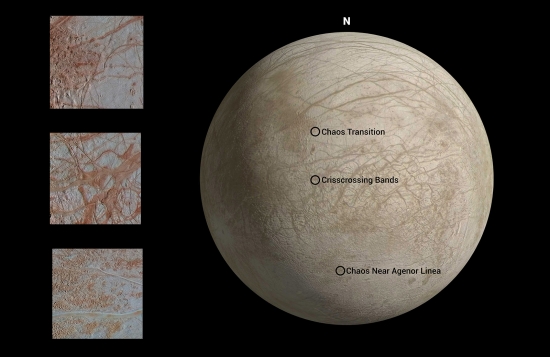
Image: The locations on Europa depicted in the newly processed images, with Chaos Transition at top. This image is centered approximately at 6.4 degrees north latitude, and 135.3 degrees east positive longitude. Credit: NASA/JPL-Caltech/SETI Institute.
Original plans for a Europa orbiter were scrapped at least partly due to concerns over the radiation levels produced by Jupiter’s magnetosphere. Instead, we’ll get over 40 close flybys as Europa Clipper makes its way around the giant planet in an elliptical orbit. The JUICE mission will conduct two Europa flybys of its own, while adding multiple flybys of Callisto before settling into orbit around Ganymede. By the end of this decade, then, we should start updating these spectacular images with high-resolution views of entirely new terrain, and the long wait for a return to Europa will finally end.

Limitless Space Institute Establishing Research Grants
Harold “Sonny” White’s investigations into controversial concepts like EMdrive and Alcubierre warp drive physics at Eagleworks Laboratories (located at the Johnson Space Center in Houston) received a good deal of attention in the interstellar community. In a recent email, Dr. White told me that he left NASA in December of 2019 and is now affiliated with the Limitless Space Institute, serving as its Director of Advanced Research and Development. The recently launched LSI is creating a series of initiative grants in support of interstellar research. What follows is the news release LSI has just released.
Limitless Space Institute announces biennial Interstellar Initiative Grants (I2 Grants)
Limitless Space Institute is launching biennial research grants with the goal of providing measurable and consistent support for pursuing interstellar research called Interstellar Initiative Grants. This call for proposals is seeking to support grants that can be categorized as either a tactical grant (?$100k) or a strategic grant (?$250k), with the former focused on research papers and the latter on laboratory testing. The anticipated period of performance for the grants is expected to be ~12-14 months in duration, with a start date by the end of September 2020. It is LSI’s vision that by establishing the Interstellar Initiative Grants, and by conducting these grant awards on a biennial cycle, LSI will help grow and mature the capabilities of the interstellar research community. For more information, see https://www.limitlessspace.org/
Email Contact: jan@limitlessspace.org
About LSI
Limitless Space Institute is a non-profit organization whose mission is to inspire and educate the next generation to travel beyond our solar system and to research and develop enabling technologies. LSI advances the pursuit of relevant deep space exploration R&D through the following three approaches:
• Internal R&D: pursuing in-house basic research at the Eagleworks Laboratories near Johnson Space Center.
• External R&D: directly funding selected R&D projects through I2 Grants.
• Collaborative R&D: advancing research in collaboration with university partners.
LSI was founded by Dr. Kam Ghaffarian, previously founder of the award-winning contractor Stinger Ghaffarian Technologies and recognized by Ernst & Young as Entrepreneur of the Year. LSI’s president is Brian “BK” Kelly, who served with NASA for 37 years, most recently as Director of Flight Operations, responsible for selecting astronauts and planning and implementing human spaceflight missions. Dr. Harold “Sonny” White leads LSI’s Advanced R&D, bringing decades of research experience in the advanced power and propulsion domain, most recently serving as the NASA Johnson Space Center Engineering Directorate’s Advanced Propulsion Theme Lead.

Image: A Bussard ramjet in flight, as imagined for ESA’s Innovative Technologies from Science Fiction project. Credit: ESA/Manchu.

Kepler-88’s Planetary Dance Grows More Complicated
Transit timing variations are useful to astronomers trying to learn what forces are acting upon a known exoplanet. They could eventually help us ferret out the existence of a sufficiently large moon, for example, though we have yet to confirm one. But they also show us how much impact other planets in the same system can have upon the planet being observed.
All this is why the Kepler-88 system has been high on the list of interesting targets for astronomers. Before the recent discovery of a new gas giant, we knew about Kepler-88 b and c, one of them (the outer world Kepler-88 c) about 20 times more massive than Kepler-88 b, a planet less massive than Neptune. The story here was the mean motion resonance, in which planet c, a Jupiter-mass world, orbits the star in 22 days while Kepler-88 b orbits in 11: Two orbits of b in the time it takes c to make a single orbit. Planet b is the only transiting planet in this system; Kepler-88 c was confirmed by radial velocity methods.
The mass differential is telling, so that the more massive Kepler-88 c causes notable transit timing variations in Kepler-88 b. In fact, the Kepler mission was able to detect TTVs of up to half a day forced by Kepler-88 c. These are to my knowledge the largest transit timing variations yet observed. All of that makes the system interesting in its own right, but now we have word of another planet here, Kepler-88 d, which turns out to be about three Jupiter masses.
The radial velocity discovery, which also confirmed the existence, mass and orbital period of Kepler-88 c, was made by a team led by Lauren Weiss (University of Hawaii Institute for Astronomy), using the High-Resolution Echelle Spectrometer (HIRES) instrument on the 10-meter Keck I telescope in Hawaii. The discovery paper appears in The Astronomical Journal.
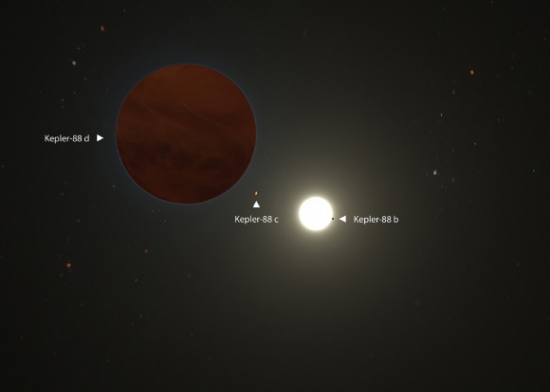
Image: An artist’s illustration of the Kepler-88 planetary system. Credit: W. M. Keck Observatory / Adam Makarenko.
“At three times the mass of Jupiter, Kepler-88 d has likely been even more influential in the history of the Kepler-88 system than the so-called king, Kepler-88 c, which is only one Jupiter mass,” says Weiss. That influence is a reference to the effects of a gas giant in a Jupiter-like orbit (the planet is in an elliptical orbit around Kepler-88 with a period of four years). Jupiter is assumed to have affected cometary orbits in the early days of the Solar System, drawing materials rich in volatiles into the inner system where they would have been part of the mechanism for producing oceans on Earth.
But this is a stellar system that will have a much different fate than our own. The host star Kepler-88 is a massive B-class object, highly luminous and with a lifetime lasting only in the low millions of years. No habitable zone worlds to nourish with oceans or, at least, no such worlds with a billion-year timeframe for life to flourish.
ADDENDUM See andy’s comment below, and also Mike Fidler’s — the B-class statement in the paragraph above is is incorrect, and the result of discrepancies between the sources. It looks as though this is a G-class object and I’m trying to confirm that.
Later: I’m going with andy’s assessment — this is a G-class star, as given by the paper’s data on it: 5466 K, 0.985 solar masses and 0.900 solar radii. Other sources also peg it as a G, so I think we have to assume that the B-class identification that appears in some online sources is incorrect.
Even so, it’s friendly to planet formation. According to the paper, finding multiple giant planets is not surprising, because of the high metallicity of the star. The paper goes on to speculate about planet formation and the likelihood of early migration:
Since both planets c and d are gas giants, they must have formed early in the disk lifetime, when gas was abundant… Perhaps additional giant planets were present earlier, or are still present. Planets c and d likely underwent viscous (Type I) migration in the proto-planetary disk. As the gas disk dissipated, planet-planet scattering would likely have increased, and low and high-eccentricity migration likely became important at this time. The high eccentricity of planet d probably arose due to a significant exchange of angular momentum with another gas-giant planet.
The smaller Kepler-88 b, then, may have formed when gas was less abundant in the early disk, and the authors believe that the world could have been caught in its current mean motion resonance with Kepler-88 c during the period of early inward migration of planet c.
The paper is Weiss et al., “The Discovery of the Long-Period, Eccentric Planet Kepler-88 d and System Characterization with Radial Velocities and Photodynamical Analysis,” Astronomical Journal Vol. 159, No. 5 (29 April 2020). Abstract / Preprint.


